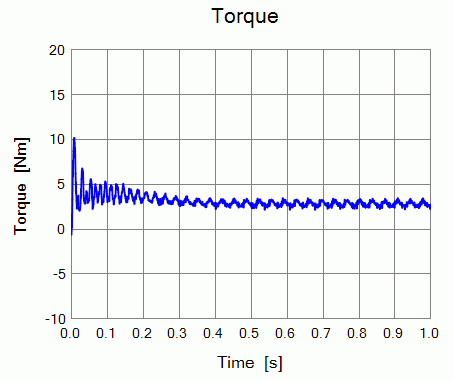
CAE Software【Femtet】Murata Software Co., Ltd.

Example4 Starting Characteristics of Induction Motor
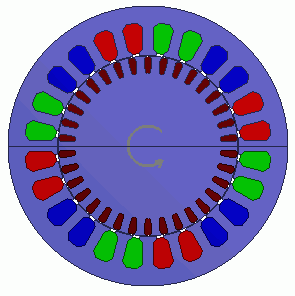
General
-
A cage structure three-phase induction motor is analyzed.
The magnetic field of coils on the stator generates eddy current at the conductor on the rotor.
The magnetic fields generated by eddy current and stator create the torque which rotates the asynchronous motor. -
The motion coupled analysis is applied.
-
The analysis begins from the stationary state of the model. The rotation is gradually increased and reaches the stable state at about 1000[r/min].
-
The rotation velocity, torque and magnetic flux density are solved.
-
Unless specified in the list below, the default conditions will be applied.
Analysis Conditions
|
Item |
Setting |
|
Solver |
Magnetic Field Analysis [Luvens] |
|
Analysis Space |
2D |
|
Analysis Type |
Transient Analysis |
|
Unit |
mm |
|
Options |
Select External Circuit Coupling. Select Rotating machinery.
[Conversion] Model Thickness: 4.2×10^-2[m] Select Partial Model. Number of Divisions of the Whole Model: 2 Circuit Configuration Number of Series: 1 Circuit Configuration Number of parallels: 2 Select Convert the result to the whole model and output it. |
The Rotating Machinery tab is set as follows.
|
Tab |
Setting Item |
Setting |
|
Rotating Machinery |
Rotational Movement |
Select Motion Equation Coupling |
|
Number of Slide Mesh Divisions |
Circumferential Division Angle: 0.5[deg] Number of Slide Mesh Layers: 3 |
|
|
Setting Motion Equation Coupling |
Moment of Inertia |
Inertial Moment of Rotor: 6.269×10^-4[kg*m2] Inertial Moment of Load: 3.0×10^-3[kg*m2] |
|
External Torque |
Waveform: Constant 0[N*m] |
|
|
Coulomb Friction Torque |
Waveform: Coefficient Coulomb Friction Torque: 0.5×10^-5[N*m] Viscous Friction Coefficient: 0[N*m/(r/min)] Squared Load Torque Coefficient: 1.226×10^-6[N・m/(r/min)2] |
|
|
Initial Time State |
Number of Rotations: 0[r/min] Rotor’s Initial Rotation Position: 0[deg] |
External circuit is as follows.
50[Hz] three-phase AC voltage is applied.

Set the Mesh Tab as follows.
|
Tab |
Setting Item |
Setting |
|
Mesh |
Meshing Setup |
Automatically set the general mesh size: Deselect General mesh size: 2[mm] |
|
Ambient Air Creation |
Select Create ambient air automatically Ambient Air Scale: 1.2 |
The Transient Analysis tab is set up as follows.
One second is divided into 800 steps.
|
Tab |
Setting Item |
Setting |
|||||||
|
Transient Analysis |
Time step |
Manual |
|||||||
|
Table |
|
Graphical Objects
A rotor cage consisted of conductor and rotor core is placed in the center. A stator core and coils are placed around it.
This is a 2D model analysis. By utilizing the symmetry of the analysis model, it is made to be a half period symmetric model.
“Ambient Air Creation” is selected.
Small mesh size is (0.3mm) is applied to the gap.
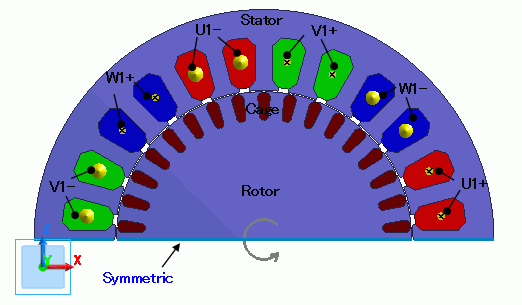
Body Attributes and Materials
|
Body Number/Type |
Body Attribute Name |
Material Name |
|
25/Sheet |
Cage |
Al |
|
26/Sheet |
Cage |
Al |
|
27/Sheet |
Cage |
Al |
|
28/Sheet |
Cage |
Al |
|
29/Sheet |
Cage |
Al |
|
30/Sheet |
Cage |
Al |
|
31/Sheet |
Cage |
Al |
|
32/Sheet |
Cage |
Al |
|
33/Sheet |
Cage |
Al |
|
34/Sheet |
Cage |
Al |
|
35/Sheet |
Cage |
Al |
|
36/Sheet |
Cage |
Al |
|
37/Sheet |
Cage |
Al |
|
38/Sheet |
Cage |
Al |
|
39/Sheet |
Cage |
Al |
|
40/Sheet |
Cage |
Al |
|
41/Sheet |
Cage |
Al |
|
24/Sheet |
Rotor |
50A1300 |
|
65/Sheet |
Stator |
50A1300 |
|
67/Sheet |
U1+ |
Cu |
|
68/Sheet |
U1+ |
Cu |
|
69/Sheet |
W1- |
Cu |
|
70/Sheet |
W1- |
Cu |
|
71/Sheet |
V1+ |
Cu |
|
72/Sheet |
V1+ |
Cu |
|
73/Sheet |
U1- |
Cu |
|
74/Sheet |
U1- |
Cu |
|
75/Sheet |
W1+ |
Cu |
|
76/Sheet |
W1+ |
Cu |
|
77/Sheet |
V1- |
Cu |
|
78/Sheet |
V1- |
Cu |
The material properties are set up as follows:
|
Body Attribute Name |
Tab |
Settings |
|
Cage |
Stator/Rotor/Air |
Rotor |
|
Rotor |
Stator/Rotor/Air |
Rotor |
|
Stator |
Stator/Rotor/Air |
Stator |
|
U1- |
Current |
Waveform: External Circuit Coupling Coil name on the circuit: U1 Turns: 66[Turns] Direction: – Y Direction |
|
Stator/Rotor/Air |
Stator |
|
|
U1+ |
Current |
Waveform: External Circuit Coupling Coil name on the circuit: U1 Turns: 66[Turns] Direction: +Y Direction |
|
Stator/Rotor/Air |
Stator |
|
|
V1- |
Current |
Waveform: External Circuit Coupling Coil name on the circuit: V1 Turns: 66[Turns] Direction: – Y Direction |
|
Stator/Rotor/Air |
Stator |
|
|
V1+ |
Current |
Waveform: External Circuit Coupling Coil name on the circuit: V1 Turns: 66[Turns] Direction: +Y Direction |
|
Stator/Rotor/Air |
Stator |
|
|
W1- |
Current |
Waveform: External Circuit Coupling Coil name on the circuit: W1 Turns: 66[Turns] Direction: – Y Direction |
|
Stator/Rotor/Air |
Stator |
|
|
W1+ |
Current |
Waveform: External Circuit Coupling Coil name on the circuit: W1 Turns: 66[Turns] Direction: +Y Direction |
|
Stator/Rotor/Air |
Stator |
The material properties are set as follows.
|
Material Name |
Tab |
Properties |
||||||||||||||||||||||||||||||||||||||||||||||||||||||||||||||||||||||||||||||||||
|
Al |
Electric Conductivity |
Conductivity Type: Conductor Conductivity: 1.02×10^7[S/m] |
||||||||||||||||||||||||||||||||||||||||||||||||||||||||||||||||||||||||||||||||||
|
Cu |
Electric Conductivity |
Conductivity Type: Conductor Conductivity: 5.977×10^7[S/m] |
||||||||||||||||||||||||||||||||||||||||||||||||||||||||||||||||||||||||||||||||||
|
50A1300 |
Permeability |
Magnetization Characteristic Type: Select B-H curve B-H Curve Table
|
Boundary Conditions
Symmetric period boundary is set.
|
Boundary Condition Name/Topology |
Tab |
Boundary Condition Type |
Setting |
|
Symmetric |
Symmetry/Continuity |
Periodic |
Rotation Period (1 period) |
Results
The distribution of the magnetic flux density right after the start is shown below.
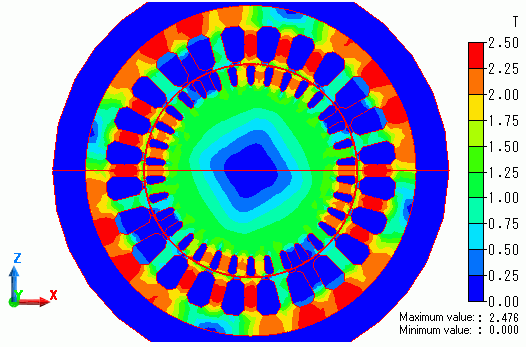
The distribution of eddy current density is shown as follows.
Eddy current is generated at the cage conductor by the magnetic flux created by the coils.
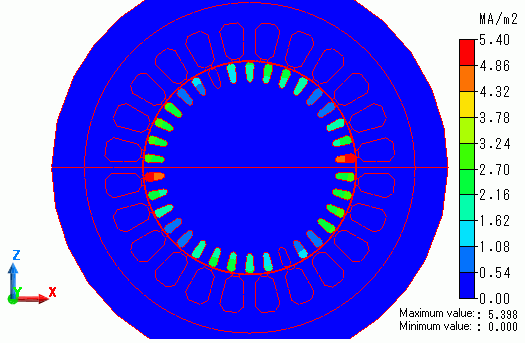
The diagram below shows time-rotation velocity characteristic.
The rotation is gradually increased and reaches the stable state at about 1000[r/min].
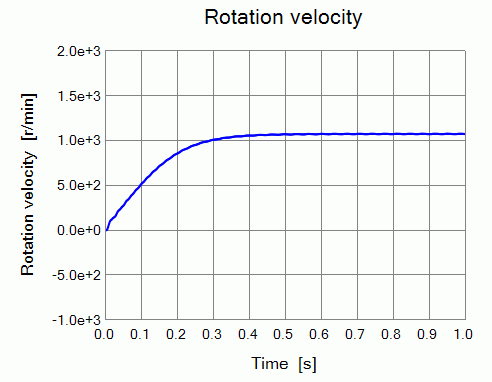
The diagram below shows time-torque characteristics.
